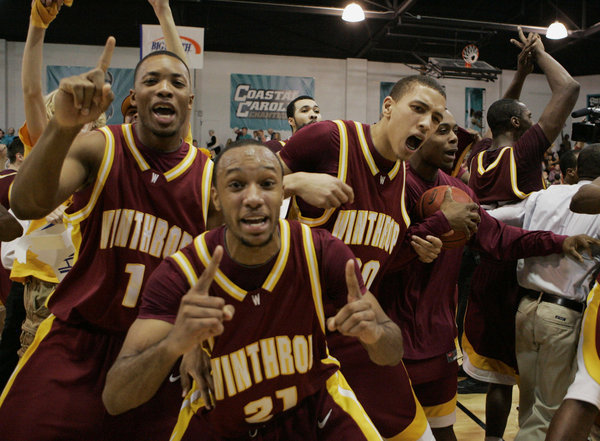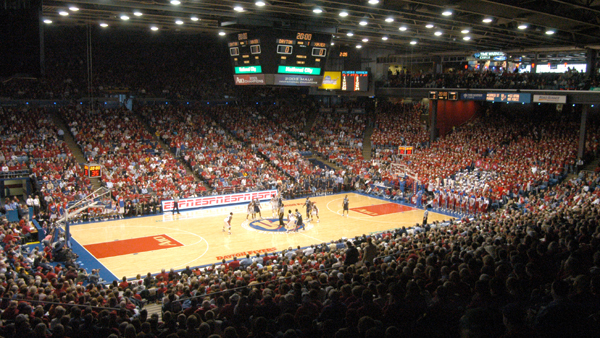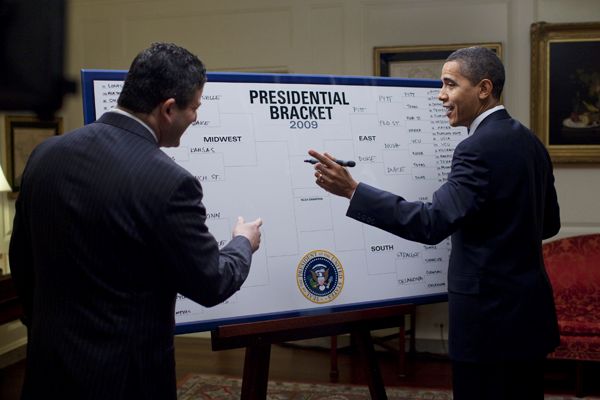Opening Round Questions Still Unanswered
Posted by jstevrtc on July 2nd, 2010Andrew Murawa is the RTC correspondent for the Pac-10 and Mountain West conferences and an occasional contributor.
The NCAA Men’s Division I Basketball Committee met this week in Chicago, and the biggest item on their agenda was to decide on the format of the new 68-team tournament. In deciding to expand from the 65-team tournament, which has been the rule for the last ten years, to 68 teams in time for the 2011 tournament, the NCAA has committed itself to four opening round games. The questions of who will play in those games, however, and where those games will take place, among other logistical issues, are still to be decided. While it doesn’t look like a decision will be announced this week, outgoing committee chairperson and UCLA athletic director Dan Guerrero has spelled out three possible options for who will compete in the opening round games:
- The teams that would be the 16th and 17th seeds in a bracket, or those teams seeded at spots 61 through 68 in the overall field — likely teams from the historically one-bid conferences,
- The last eight non-automatic qualifiers or the teams generally referred to as bubble teams — generally teams from a mixture of BCS leagues and mid-major conferences, or
- Some combination of the first two options, with the most talked-about scenario being the last four bubble teams playing in a couple of games and the lowest seeded automatic qualifiers (seeds 65-68) playing in the other two.
While it is still within the realm of reason that additional options could arise (maybe the lowest seeded automatic qualifiers each match up against one of the bubble teams), the answer will likely be one of the three options above. And, frankly, option three is a bit of a copout, so the decision between options one and two comes down to something of a battle between the big power conferences and the less influential conferences that nonetheless make up the bulk of Division I. And neither side wants to play in those games.

Should a conference champ be sent to an opening-rounder and have a better chance to make more money, or should their performance be rewarded with a spot in the main draw?
“I think that if you are an automatic qualifier, you should not be in a play-in game,” said Winthrop head coach Randy Peele when we talked with him earlier this week, and he’s had experience with the opening round game as the coach at a school that has now appeared in two opening round tournament games, including last season’s loss to Arkansas-Pine Bluff. Peele’s sentiment was echoed by Michael White, the Associate Athletic Director for Communications at East Tennessee State University. “For teams like ours that come out of a league with one tournament bid, and to have to earn it by winning our conference tournament, we don’t want to have to be sent to a play-in game.”
Even the term “play-in game,” used in reference to the single opening round game played in Dayton for the last ten years, is a divisive one. The NCAA has gone to great lengths to make sure that game was referred to as the “opening round game,” despite it commonly being referred to by fans and media as the play-in game. “The way the NCAA markets the first day is critical,” said ETSU’s head coach Murry Bartow. “They shouldn’t be marketed as play-in games, where you’re not even in the tournament until you win that game.”
It’s true, the opening round game is considered every bit as much a part of the NCAA Tournament as the other 63 games, as far as the NCAA is concerned. As a result, participants in opening round games receive a full NCAA Tournament game share, which is the approximately $220,000 that every school that competes in any NCAA Tournament game receives. A win guarantees a school two tournament shares, or $440,000, a sum which is nothing to gloss over, especially for smaller schools. And that fact provides at least one positive, should teams from the one-bid conferences wind up in these games. “It does provide a chance for schools like ours to get a win in the NCAA Tournament,” said White, later mentioning that the chance for the extra money is a significant carrot for some schools from smaller conferences. “We are aware of schools on the cusp of being in that potential 16/17 game who are lobbying the NCAA to be in that game so they’ll have a chance to be on national television and get that extra tournament share.”
On the other side of the coin, teams and conferences who have a chance to be among the last eight at-large teams into the tournament also don’t want to play in the opening round games, given that in almost every case, they will have a better overall tournament resume than the automatic bid winners from one-bid leagues. For these schools, there are a number of motivations to avoid the opening round games. First, and most obvious, it is just another roadblock along the way for these schools to advance through the bracket, but there is also the likelihood that some of these schools just got done playing their conference tournaments while some of the one-bid leagues have already had a week off. There is also the concern, referenced by some of the Big East coaches and athletic directors in voting to eliminate the double-bye in the Big East tournament, that teams which have already had a chance to play in the tournament and gotten through the opening round game may have an advantage over their first round opponent who has yet to get rid of the NCAA Tournament butterflies, and may even be slightly out-of-sync after a few days off between games.
Examining comments from the outgoing tournament chair, Guerrero, and incoming tournament chair Gene Smith, the athletic director from the Ohio State University, reveals that there is no consensus on the committee. Guerrero was previously quoted as saying that putting the lowest eight seeds in the tournament field into the opening round games would help the committee stay “true to the seed process,” while Smith told the Columbus Dispatch this week that “the teams on the 17th, 16th and 15th lines, they’re conference champions. The last eight in are fifth in their league, sixth in their league, maybe even seventh in their league. They’re not champions,” implying that the conference champions have earned the right to avoid the opening round matchup.

Dayton -- both the city and the university -- has served as host for the so-called "play-in game" for ten years, and has done so with excellence.
The other big concern facing the committee regarding the opening round games is the location. Dayton has hosted the opening round game for the last ten years, and by all accounts has done a great job, with the average attendance for the game measuring over 8,000 fans during that span. While a handful of possibilities have reportedly been discussed by the committee (including playing opening round games at the “first round” sites to which the winner would advance), all four games will likely be played at one site, with Dayton and Indianapolis the favorites to host those games, according to Smith. This, too, is a potential problem for the participants in the opening round games. “The logistical issues involved in preparing to play on Tuesday night are rather difficult to say the least,” said Jack Frost, the Assistant Athletic Director for Media Relations at Winthrop. “When you don’t know for certain until Sunday evening that your team will be involved in the opening round game, it creates somewhat of a nightmare for everyone involved, including the coaching staff, student-athletes, support staff and fans/boosters. This past March, following the Selection Sunday announcement, our players and fans went to bed not knowing what time our travel party would depart the next morning for Dayton.”
For Coach Peele, the main concern should be the student-athletes. “If you have the play-in games, have them at the same site as the first round. Make them feel a part of the tournament. Take care of the players. Make them feel a part of the greatest sporting event ever.” At this point, it seems like such a scenario is unlikely. A full day at one location with four opening round games being played, though, would feel very much like the true opening day of the tournament, with fans from eight different schools there to support their teams over the course of what would undoubtedly be an interesting day of basketball, regardless of the competitors or location.
The other consideration that will be taken into account by the committee when these decisions are made is the wishes of the television networks that paid $10.8 billion for the rights to these games, and by extension the fans who will watch those games on those television networks. As much as your hardcore basketball fan may be sucked in by the prospect of an East Tennessee State/Winthrop battle for a chance to advance and face a 1-seed in the first round, the idea of four games between bubble teams (think Virginia Tech/Illinois as an example of teams on last season’s tournament bubble) would likely be far more compelling and attractive on national television. The fact that, in the process, the NCAA would be throwing something of a bone to one-bid conferences and allowing them to bypass the opening round game is just gravy.

The days of the symmetric bracket are actually back...sort of. But Messrs. Obama and Katz will still need a new eraser board.
One last important piece of the puzzle: the actual layout of the bracket. Like it or not, a major attraction to the NCAA tournament for the average casual college basketball fan is the fun of filling out a bracket and competing against their friends, family and coworkers in bracket pools. In terms of keeping the brackets easy to understand, sending the lowest eight seeds to the opening rounds games is the better option. In that scenario, the winner of the opening round game would be a heavy underdog to their 1-seed opponent in the next round, meaning that when the casual basketball fan ignores the opening round game in their bracket and just blindly (and, to this point, entirely correctly) fills in the 1-seed to advance to the second round, there is no confusion. If, however, the last eight at-large teams are playing for a 12-seed, for example, the winners of the opening round games have far greater chances for victories in their first round matchups against the 5-seeds, wrecking brackets throughout the land. Without a doubt, this is not a major criterion upon which the tournament committee will base their decision, but all other things being equal, this is a consideration that could tip the scales ever so slightly.
In the end, it is still the NCAA Tournament, no matter how the committee decides on the whos, hows and wheres of the opening round games. And it is still, as Coach Peele put it (and we certainly agree), “the greatest sporting event ever.” The outcome of this deliberation is not going to ruin the fun of the tournament by any means. Regardless of the decision, that slate of games on the Tuesday after Selection Sunday will be a fun event for fans at the event as well as those watching at home. The decision regarding location may, however, tip the NCAA’s hand in terms of whether the big conferences or the little conferences are favored (and, really, the NCAA isn’t even making much of an attempt to bluff on that topic), so it might be nice to see the committee show a little respect towards the one-bid leagues. What remains to be seen is whether that is in the form of avoiding the opening round games and getting a pass into the first round or getting put into the first round games and getting a better chance at winning a tournament game and the pursuant extra tournament share. Once these decisions are made, and the first new version of the bracket is announced in March 2011, the teams in the tournament openers will be more excited about their opportunities to play the games than upset about where they got placed. As ETSU’s White put it, “the NCAA tournament is so much fun that no matter what happens, if we have to play in one city and then get on a plane and go to another, we’ll be glad to do that.”










































As much as I hate to say it the 68 team tournament causes much more of a headache than a 96 team tournament. No one is going to watch the 8 teams that play unless you are basketball-nut or an alumni of the schools involved. Can we please go back to 64? The tournament was pure then.